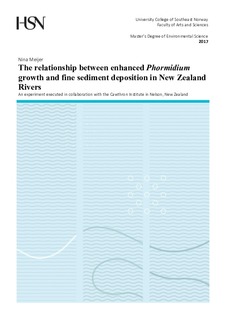| dc.description.abstract | The proliferation of cyanobacteria dominated mats have been reported to be increasing in New Zealand rivers over the last decade. Phormidium is one of the genera dominating benthic mats in New Zealand rivers and have the potential of producing the neuro-blocking toxins anatoxin-a and homoanatoxin-a, that are harmful to animals and human health. The proliferation of Phormidium blooms is often related to river nutrient concentrations, primarily dissolved inorganic nitrogen (DIN) and dissolved reactive phosphorus (DRP). However, field studies have observed an increase in Phormidium blooms despite low DRP concentrations which prompts the question as whether the Phormidium mats are capable of utilizing other sources of phosphorus, such as sediment-bound phosphorus.
A five-week experiment was conducted at the Cawthron Institute to study relationships between enhanced growth of Phormidium mats and fine-sediment deposition. The experimental design consisted of four channel setups with a water flow-through system set up to simulate a river environment as closely as possible. Each channel consisted of nine Phormidium-inoculated cobbles resulting in a total of 36 cobbles per set of channel treatment, leaving it with 144 cobbles in total. Treatment A functioned as control and amounts of fine sediment (< 63 µm) of 4 g, 10 g and 20 g were added to treatments B, C and D, respectively. Physio-chemical water parameters were measured consistently throughout the experimental period to prevent any parameters other than the sediment concentrations from affecting Phormidium growth. To maintain controlled nutrition levels across all experimental treatments, the water was spiked with nitrate (NO3-) and phosphate (PO43-) every week. Biomass and biovolume were sampled for analysis every week in addition to tracking the changes in Phormidium mat size over time.
Analysis of ash free dry weight show that the samples primarily were composed of inorganic content, reflecting the sediment deposition. The presence of organic and inorganic material experienced an increase throughout the experimental period, were only treatment A and B show a slight decrease in organic content on sampling day 28. Two-way ANOVA shows statistically significant differences between the organic content (g/m2) and treatments for sampling day 5 (p = <0.001), sampling day 23 (p = 0.001) and sampling day 28 (p = <0.001). A Two-way ANOVA followed by a Post-Hoc Tukey HSD shows that the statistical differences are the greatest between treatment D (day 28) and C (day 28), and between treatment D (day 22) and treatment D (day 28).
The Phormidium biovolume increased until day 23 of the experiment and experiences a decrease on sampling day 28. The maximum Phormidium biovolume occurred in treatment B on sampling day 23, with an average of 388 mm3/m2. Post-Hoc Tukey HSD shows that the Phormidium biovolume between sampling day 5 and 23 differ significantly (p = 0.026). Analysis of Phormidium-mat sizes overall show a positive growth tendency in all treatments. Treatment C and D show the greatest mat expansion during the period of analysis. Treatment D reaches the highest mat cover on sampling day 15 with an average of 0.513 m2. From day 17 to 22 image analysis show that all surface Phormidium mat coverage experience a major decrease in size. Photographs that were analysed from day 22 and after show the Phormidium mats are clearly being dominated by a cover of diatoms.
The Phormidium mats for this experiment appear to grow well with the quantities of sediment added until environmental changes within the water column became favorable for diatoms to settle on the Phormidium mats. This is suspected to have arisen due to turbid river water collected from the Maitai River (Nelson, New Zealand) and added to the experiment set up in order to maintain consistent levels of water. The water may have added a new taxa to the experiment containing washed of diatoms deriving from upstream the Maitai River. | nb_NO |
